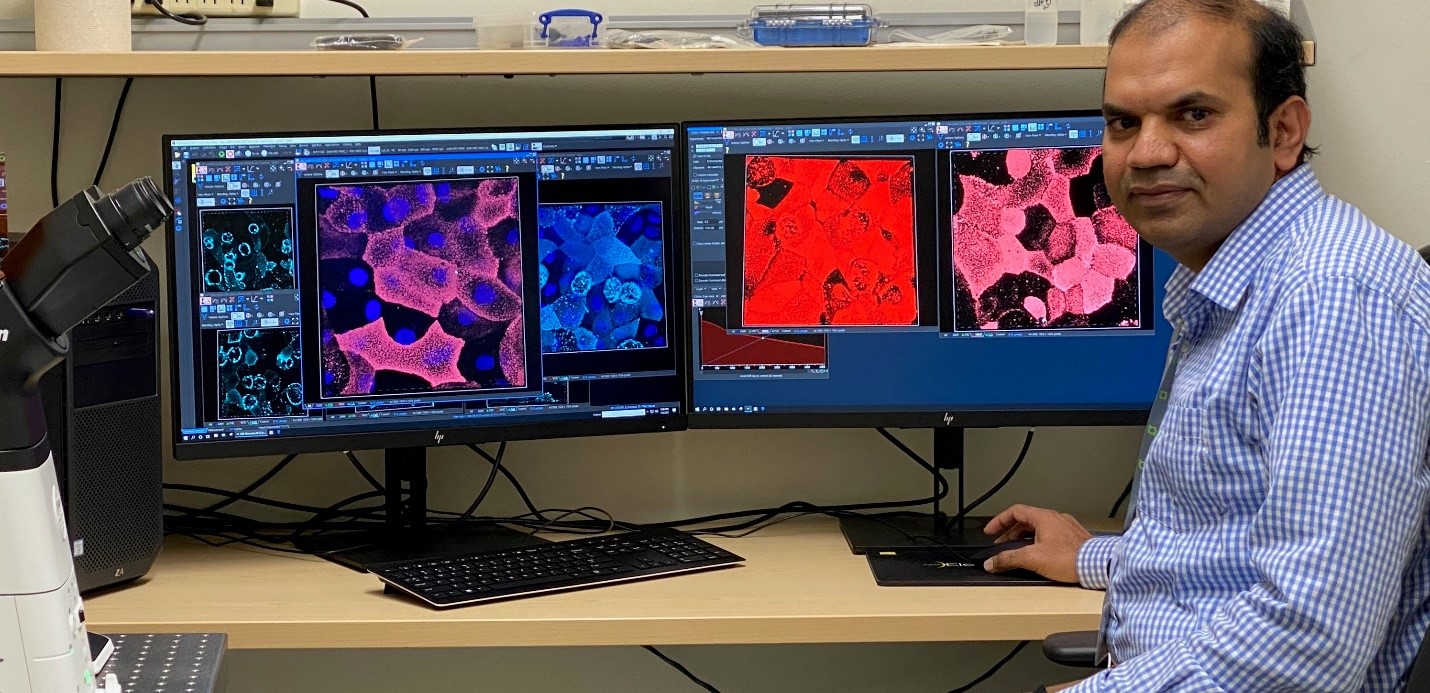
Scientists unlock a key to ETEC diarrhea’s long-term consequences

Photo: Dr. Alaullah Shiekh, a postdoctoral researcher in Dr. James Fleckenstein’s lab at Washington University in St. Louis, is hard at work analyzing images of ETEC’s effects on the human gut.
Short-lived diarrheal infections can sometimes result in a long-term disorder known as environmental enteric dysfunction (EED), which can cause malnutrition, stunted growth, and cognitive deficits. One of the worst offenders for EED is a bacterium called enterotoxigenic (i.e., toxin-producing) E. coli, or ETEC. ETEC is one of the top six pathogens responsible for severe childhood diarrheal infections. Its burden is multiplied when considering both deaths and illness (measured in disability-adjusted life-years) due to ETEC’s long-term consequences.
But while we can observe and measure the long-term consequences of EED due to ETEC diarrhea, scientists were previously unsure of exactly how, on a biological level, ETEC resulted in EED. Now, thanks to researchers in Dr. James Fleckenstein’s lab at Washington University School of Medicine in St. Louis, we may have a better idea. The key, as published in the Proceedings of the National Academy of Sciences, may lie in the ability of the toxin produced by the bacteria to hijack cells in the gut. We spoke with Dr. Fleckenstein to learn more.
DefeatDD: What led you to become interested in ETEC diarrhea?
Dr. Fleckenstein: Decades ago, people worked out how this toxin produced by E. coli causes diarrhea. The bacterium’s so-called heat-labile toxin causes ion channels on intestinal cells to open, triggering an outpouring of water and electrolytes into the digestive tract — in other words, severe, dehydrating watery diarrhea. But a superb postdoctoral researcher, Dr. Alaullah Shiekh, and I had begun to speculate that the heat-labile toxin might be doing more than just causing acute diarrhea and dehydration. If so, it might begin to explain the link between ETEC and malnutrition, stunting, and other long-term problems. With the availability new molecular tools, we decided to try to piece together how ETEC might be driving malnutrition and other cascading effects of diarrhea.
DefeatDD: So what did your team do to investigate this toxin’s effects on the gut?
Dr. Fleckenstein: With extraordinary help from our collaborators, we managed to combine multiple molecular approaches. To see what was happening on a molecular level, we grew human intestinal cells in a Petri dish, treated the cells with the toxin, and then tracked and analyzed the changes—including gene expression. To confirm these observations with what happens in the real world, we also looked at intestinal biopsy specimens from people in Bangladesh infected with ETEC.
DefeatDD: What did you learn?
Dr. Fleckenstein: Well, our suspicion was correct. It turns out this toxin has pretty drastic effects on the human digestive tract. We learned that the toxin activates a set of genes, changing gene expression in the cells that line the inside of the small intestine, which is where all your vitamins and nutrients get absorbed. The change in gene expression induces the cells to manufacture a protein (called CEACAM6) that the bacterium then uses to attach to the intestinal wall and deliver even more toxin.
Basically, the toxin changes the surface of the intestine to benefit itself. These changes may be to the long-term detriment of the host.
DefeatDD: What are the potential implications of these findings?
Dr. Fleckenstein: There is still a lot more research to be done, but this is one of the first pieces of evidence that ETEC can change the intestinal surface. And it stands to reason that damage to this part of the body could affect the ability to absorb nutrients. Particularly for young children in low-resource, high-risk settings, these findings could offer early insight into one of the underlying causes of malnutrition and stunting and inform prevention strategies, particularly vaccines.
We’re very excited about the potential for ETEC vaccines, which are closer than ever to becoming reality. By preventing diarrheal infections from bacteria like ETEC and Shigella and stopping dangerous toxins from causing permanent damage to children’s guts, these vaccines could also potentially help vaccinate against malnutrition.


